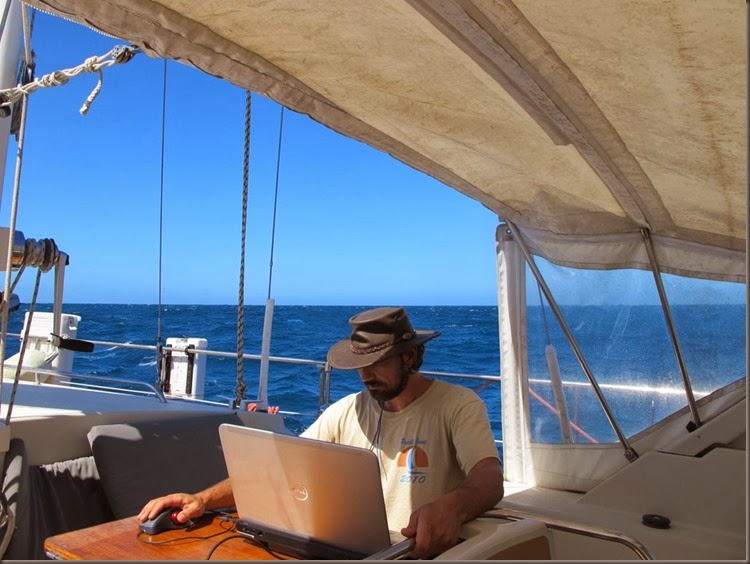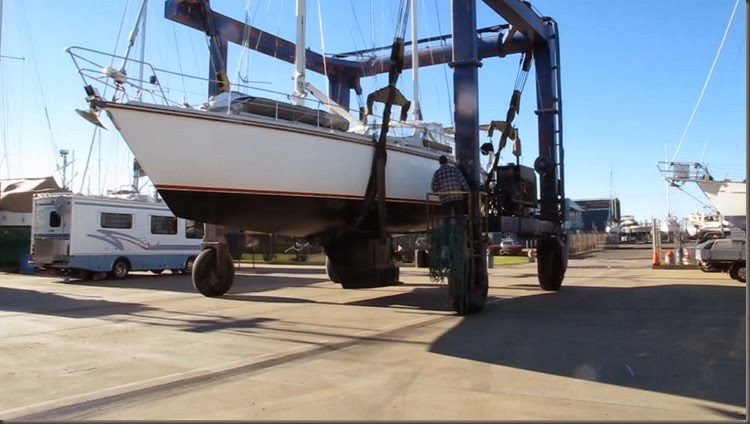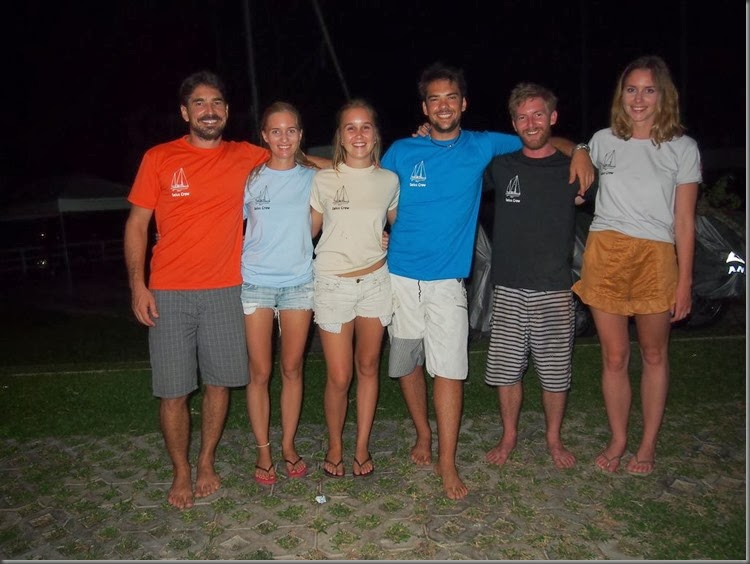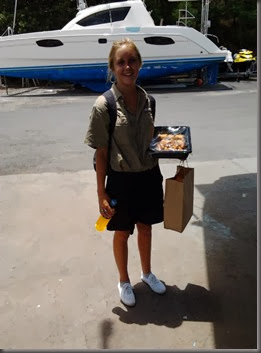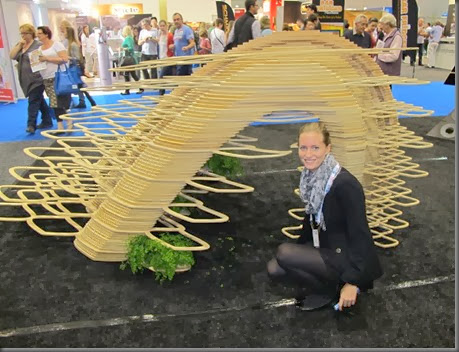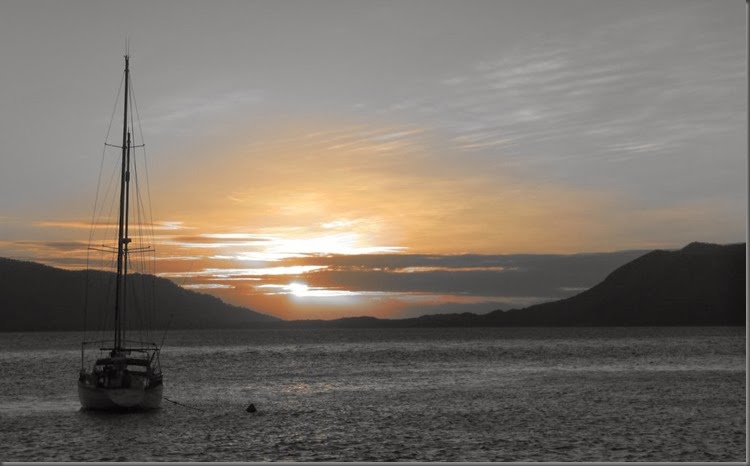So now that the history of how I got a boat and a mortgage is covered how do we actually afford to sail NOW, after the cruising kitty has long run dry? Below are just a few options that we’ve run across on our trip. There is no one answer, no silver bullet. I’m sure there are many more, it’s just what we do.
The four main things Delos does is:
- I still work remotely from the boat on IT projects a few hours a day. (see Work While You Sail)
- When not sailing everyone works like crazy to save up money for the next season. (see Take a Sabbatical From Sailing)
- Everyone on Delos pays their own way, including friends and family that visit us. (see Sail With Friends And Family)
- Get jobs and make money whenever and where ever we can. (see Work Overseas)
Best office view in the world.
#1- Work While You Sail
This could either be the best thing ever or the worst thing ever, depending on how you look at it. If you can find a good balance between working and living the cruising life then it’s an an awesome way to keep some funds in the bank. Of course you need a skill set and potential employer that lends itself to this type of arrangement. I’ve done this since Delos was in Bundaberg, Australia and still struggle a bit with separating work and life but for the most part it’s been pretty good.
Currently I’m working on the development of new versions of a software product our company has released. Basically I spend a few hours each and every day on the laptop writing code, answering emails, etc. I try to start at about 8AM and finish by 11 or so. Sometimes it’s hard to work if we’re on a tough passage where the boats banging around, and sometimes we have an adventure planned that takes up the day but overall It works out pretty good. I find working in the morning to be a very productive time and I get very few interruptions. By the time work is finished I have the rest of the day to enjoy so it’s a pretty sweet gig.
There are a few requirements to working on a boat though. First of all you’ll probably use a laptop which means consuming more power which means a beefier solarinverter setup. Delos has 600W of solar which is plenty when the sun is shining, and if not I just run the generator to charge the laptop battery. It turns out that starting with a fully charged battery gives me just enough time to work. When the battery dies I’m done for the day!
The other requirement is probably going to be internet. Delos left Seattle with a Wi-Fi antennae and booster and I’ve found it to be nearly useless so far. Very few places have open Wi-Fi and the places that do aren’t convenient for anchoring. But, the good news is 3G and mobile access is just about everywhere. We got good 3G coverage in Mexico, and even a bit of slower Edge coverage in smaller islands across the pacific. Australia and NZ have excellent 4G coverage. In fact Telstra claims to have coverage out 100KM to sea. In reality it started to fade 20KM out for us but maybe with the right directional antennae it’s possible. We saw good coverage in Fiji, Vanuatu, and some parts of the Solomons. Indonesia was pretty good and cheap. So far the best has been right now in the Philippines, where a month of unlimited 3G4G service sets you back a cool $20. I wouldn’t depend on it for day trading, but for general access and email it works pretty good. There have been a few stretches of 2 weeks or so this season where we didn’t have any sort of coverage so this has to be taken into account as a possibility. Work offline, then take advantage of connectivity when it’s there.
Other than jobs that can be done remotely from the boat for a company back home I’ve seen other people making money by repairing sails, doing electrical work, and even teaching people to dive. I can only think of a few cases of this so I think it’s actually pretty rare and difficult. Mostly because cruisers are incredibly cheap. Imagine the cheapest person you know, then double their level of cheapness. Most cruisers are still even cheaper than this, and for good reason. The majority of people are trying to stretch every cruising dollar- just like you.
Delos goes on the hard in Australia!
#2- Take A Sabbatical From Sailing
This never sounded like a good idea to me before, but after a few years of cruising I totally get it. Believe it or not even the most beautiful tropical atoll can start to lose it’s luster after a while, and taking a break from cruising can be just the ticket. You come back refreshed and with even more passion than the first time you left, because this time you know just how good it’s going to be. Hopefully you come back with some coin in your pocket too.
I’ve met a lot of boats that sail the on-season, store the boat, then fly home and work during the off-season. Our friends Chris and Jess on Namaste leave their boat on the hard in the Tuamotus for the South Pacific cyclone season and fly back to the US to work. Our friends Jeff and Amber do the same thing on SV Rockstar, but in Mexico. Our friends Steve and Prue on Keira do the same thing sailing the Philippines and working in Australia for the cyclone season.
You don’t have to do it by season either. Go for a year, or two, or more then take a break. After cruising the South Pacific for nearly three years we parked Delos in Bundaberg, Australia and took a year long break while living and working in Melbourne which was really sweet.
While Delos was parked everyone worked at whatever they could find. Josje worked at an ice cream parlor and burger joint in Australia then a butcher shop in New Zealand. Brady managed a Mexican restaurant in Melbourne then crewed on super yachts in Ft. Lauderdale. Karin got a landscape architect internship in Sweden. I worked from Australia, the US, and finally Sweden over the internet for my company back in the US. We returned totally psyched to sail again, and had put some cash in the old cruising kitty too. When the money runs out everyone will go back to work again and the cycle will start over.
There are lot’s of places to safely stash your boat and planes go upwind like you wouldn’t believe, so give it some thought. 15 minutes flying = 1 day sailing on most boats so you can get anywhere pretty quick.
#3- Sail With Friends and Family
Our first season out we met four Canadian’s on a boat named Mojumbo. They were all 21 years old and really going for it. Apparently they made a pact in high school to pool their money in order to sail to the South Pacific. When their friends were out partying they were working, always stashing cash away. They held things together and after three years of saving purchased a great cruising boat and still had enough money to get to Australia, where they got work and sold the boat.
The Delos crew has evolved over the last few years. My brother Brady joined Delos in Mexico for a few weeks and never ended up leaving. It’s been almost 4 years now! We met Karin in New Zealand, and Josje in Fiji back in 2011. We get along amazingly well and I love sailing with them so I feel very lucky. Sailing with a few people may not be an option for everybody, but for Delos it works out perfectly. Suddenly even spending $1000 to fill up with Diesel isn’t such a shocker when it’s split up.
This season we’ve had an extraordinary number of friends visit. A lot of people say “Yea, I’d love to come visit!” but this is the year where everyone actually did. In fact we’ve had 6 friends come visit this season ranging from a few weeks to a few months, so trying to track and split expenses would have been a nightmare. I did some calculations based on past seasons and now everyone on board Delos chips in $100.00 per week towards boat expenses. This covers diesel, dinghy fuel, port fees, boat maintenance, etc. So, for less than $15 per day you get all the diving and sailing you can swallow. It’s actually cheaper than most hostels. We split up food and alcohol costs evenly so to sail everyone stashes away $100 x number of weeks onboard plus enough for their portion of foodalcohol. In cheap places like Indonesia or Philippines our food cost us $25 per person per week. In more expensive places like New Zealand or Australia it was $50-$75 per week. We do eat good and don’t really skimp so it could probably be done even cheaper.
Josje and Karin doing their thing in Australia!
#4- Work Overseas
When I think of this I see two main categories. Under 30’s and professionals. I split them up because if you’re under 30 it’s super easy to get a work Visa in most places. You apply online and if you’re not blacklisted or an international criminal you should be alright. In New Zealand and Australia it’s about $200 and good for 12 months. You can legally work at pretty much anyplace that will hire you and the pay is decent. I think Josje made around $20 per hour at Huxtaburger. I’ve heard you can make even more picking fruit and doing manual labor so it’s up to you. In Australia you can get a 2nd year Visa if you spend 3 months working in “rural” or agriculture work so there’s lot’s of options. So, if you want to spend a few seasons in the South Pacific and you’re under 30 go to NZ, work for a bit, sail around some more in Fiji and Vanuatu, then go to Australia and do it all over again.
If you’re over 30 then honestly unless you marry a local or are a professional with a high demand skill (engineer, MD, nurse, etc.) it’s going to be pretty tough. Immigration sites usually have a list of their high demand careers so check it out. Luckily I didn’t have to go this route as I worked remotely for my company in the US but I know a few cruisers that have. Our friends Ken and Lori from Trim are currently settled in Melbourne putting some cash away, and our friends Jamie and Behan from Totem did the same thing in Sydney and Brisbane and are now sailing again.
One more idea to throw out here – if you’re handy on a boat (and you probably are as a cruiser) then schedule a stop at a known “super yacht” port. If you can catch these guys at the right time it’s easy to get on as a day worker and make some cash. No Visa required! Both Brady and I worked in Auckland, NZ as it’s a major stop for yachts in the South Pacific to get out of the cyclone belt before continuing to Fiji and further west. I found day work as an engineer and was paid $180-200 per day. Brady worked as a deckhand for about $160 per day. Since it was all cash in hand it didn’t take too long to save up for that new dinghy motor we needed.
And finally, some numbers I’ve managed to scrounge together. Delos is a 53’ foot and pretty systems complex so the costs can vary wildly but here’s ours and some base numbers. Hopefully this will be somewhat helpful.
Diesel
Since leaving Seattle 4.5 years ago we’ve cruised nearly 25,000 NM. During this time we’ve run the main (78HP Volvo Turbo Diesel) for 1,585 hours and the genset (Onan 7KW) for 1741 hours. We burned a total of 6154 liters. The generator burns about 1 liter per hour which puts our main at 3 liters per hour (5.5 – 6 knots for efficiency). The cheapest fuel we’ve seen is Indonesia at $.65 per liter, and the most expensive was Australia at $1.55 a liter.
Marina Charges
Living aboard in Seattle for Delos was $1,000 a month. Auckland, New Zealand was about $850 per month. Hamilton Island, Australia $1,700 per month. The hard-stand in Bundaberg, Australia was about $600 per month. The cheapest so far has been Samal Island, Philippines at about $350 per month. Nearly all marina’s charge by the foot and since we’ve over 50’ it’s much more expensive for us. We don’t go into the marina much because of this and prefer to anchor out anyway. Excluding our long stays in NZ and Australia we are at anchor over 90% of the time.
Boat Port Fees
I didn’t really keep track of this so much and am going from memory but should give you the general idea. Most places in the South Pacific are completely free or just a few dollars. In 2009 French Polynesia was about $140 including the Puddle Jump rally fee. This may have changed but it was a very easy way to get around the bond at the time. Nuie, Auitaki and a few other places in the Cooks were $20 or so but it’s been a few years so it may have changed. I don’t recall paying anything in Tonga, New Zealand, Fiji, or Vanuatu. Solomon’s was about $120 for the boat. Australia charges $300 for quarantine, and Indonesia requires a cruising permit that all-in runs about $300 (excluding bribes to officials there of course). Philippines was completely free! Check out Noonsite.com to get a better idea here.
Insurance
Delos is my house and I do pay for insurance. The most expensive I’ve had is 1.5% of boat value, and the cheapest is just under 1% of boat value for blue-water insurance.
Boat Maintenance
Obviously this will vary wildly from boat to boat. Delos has a lot of systems (electric furlerswinches, dive compressor, water maker, washing machine, etc. etc.) so lot’s of stuff breaks. She’s also going on 14 years old now and most of those have been hard cruising years so pumps, motors, seals, etc. are starting to get to their end of life. On a yearly basis the lowest maintenance expense has been 1% of boat value, while the highest in Australia (bottom paint, new turbo, battery chargers, etc) was about 5%. To keep costs down we do all the work ourselves on the boat. However, if you have no experience in how to fix a yacht, or other marine ships, then you should probably think about getting in contact with a professional company. You can contact Tess Electrical or other businesses, to see if they can fix any issues you’re experiencing with your yacht. This will ensure you and your family remain safe whilst you’re on the water. For specialty items (rebuilding a turbo charger, rewinding a motor) we do send out to a shop to get done. Check out our video “0 to cruising in 20 days” for some of the stuff we did in Australia.
Food Cost
In Australia which is very expensive we had our food cost at about $10 per person per day, or about $300 per month per person. We like to eat meat (steaks, bacon, chicken) and lot’s of fresh veggies so we could have done it a bit cheaper but were happy with this. In Indonesia and Philippines where it’s much cheaper we can eat for $3 per person per day. We still buy some Western style foods (cheese, snacks, etc.) so could make this even cheaper if we really needed to.
Liquor
With a few exceptions like Mexico and the Philippines liquor is pretty expensive. We were sticker shocked in the Marquesas at $22 for a six pack of local brew. Tahiti had duty free so that was cool. Australia is probably the worst where a case of beer was $40 to $60, and a liter of rum was $45. Because of this we bought a still and started brewing our own moonshine. Check out our “Moonshiners” blog. Philippines is the cheapest we’ve seen. Even at a bar beer is about $1 and rum is $2 a liter.
Summary
Putting it all together our cruising cost for boat stuff (excluding marinas and any major boat breakdowns) is right around $1,000 per month. With four adults on board our food is $400 (cheap places) or $1,200 expensive places. So, the total ranges from $1,400 to $2,200 per month depending on where we are. This includes food, fuel, propane, insurance, small maintenance items, port fees, and yes even alcohol (we love our still). Delos is a 53’ boat with lot’s of cool systems on board that make our life comfy so I’m sure it could be done cheaper.
When Delos first started cruising our budget was a lavish $3,000 per month with only two people on board. And guess what? We managed to spend $3,000 per month. Now a few years later as we’ve learned more and the savings has dwindled we cruise for half that with twice as many people.
So, the bottom line is you can spend as little or as much money as you have cruising. I’ve met guys out there with nothing more than hope, dreams, and a Garmin strapped around their necks with a shoelace. No refrigeration, no luxuries, just pure sailing and sunshine. I’ve also met people in multi-million dollar yachts cruising in a very different way. Delos lies somewhere between these two extremes. If I had to put a label on Delos she would be upper middle class. But guess what? Everyone anchors in the same sand, swims in the same water, and enjoys the same sunsets. The experience you choose is completely up to you.


